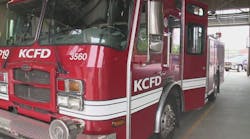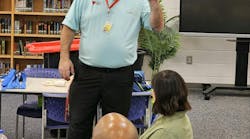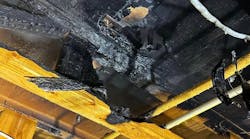Question: With so much emphasis and discussion on the many aspects of fire suppression, where is the place of fire prevention and what is the best way to tackle the fire problem, while raising its awareness within the fire service and the public?
Answer: Fire prevention has always been part of the fire protection equation. If fire protection were an iceberg, fire suppression would be the visible part above the water and fire prevention would be the huge piece below the water line. However, fire prevention is just now gaining a larger part of the fire service's attention and that of the public.
While fire prevention has always been a critical part of the total fire protection system in this country, it rarely receives the same attention from the media as fire suppression. The tragic fire at The Station in West Warwick, RI, in February 2003 that resulted in 100 deaths is an example of one of these occasions. After such a catastrophe, fire marshals are in the spotlight to explain how the tragedy occurred and what should have been done to prevent it. Unfortunately, many of the regulations on the books now are the result of this "catastrophic theory" of fire protection.
A marketing management approach to fire prevention can contribute to a solution to the problem. Last year, I participated for the second year in a series of seminars initiated through the U.S. Fire Administration (USFA) called PARADE, for "Prevention, Advocacy, Resources and Data Exchange." These seminars were dedicated to an exchange of information and techniques about fire prevention and education. Topics included inspections, public fire education, engineering, investigation and international aspects of prevention and marketing. The participants included fire marshals from around the country - metropolitan and state fire marshals as well as the senior executives of the USFA. I came away from these sessions with a better understanding of the role of fire prevention and with an enthusiasm for prevention that I did not expect. Bottom-line: fire prevention is the fire protection future of the fire service.
I found the fire prevention community - fire marshals as well as prevention and public education officers - to be one of the most market-savvy I have seen among any public service. These people embraced marketing management in a way I have rarely seen, packing all of my seminars on the various marketing topics.
PARADE has its own on-line discussion network for prevention officers from around the country. During one of these exchanges, I met the fire marshal of Peoria, AZ, Howard Munding. What caught my attention was Howard's mention that he had met with the folks from Dale Carnegie to create classes on customer service for his fire prevention officers and inspectors. A soft-spoken, modest man, he was kind enough to send to me his marketing and customer service plans for Peoria. They are among the finest I have seen in public service or private enterprise. It is with his permission that I present some the key points of the plans in this two-part series.
From fire prevention to fire community services. When Howard accepted the fire marshal position four years ago, he inherited a small division with minimal effectiveness. Peoria, just northwest of Phoenix, has grown from a small agricultural community to a large city of 185 square miles, with over 130,000 people and 1,600 commercial customers. It is the fifth-fastest-growing city in the U.S. of comparable size. The population is projected to reach approximately 154,000 by 2009 and to 230,000 by 2030.
Four years ago, the Peoria Fire Department had one inspector, one fire marshal and one public education specialist. "One of the first things we did was change the name of the division from Fire Prevention to Community Services to better reflect our total mission," Howard noted.
Because of the vision of the fire chief and the support of the city manager and council, his division now has four inspectors, one inspection supervisor, one fire protection engineer, two plans reviewers, one public education specialist, one administrative support person and one fire marshal. The department now has 130 personnel and six stations.
Last fiscal year, Peoria inspected 17,000,000 square feet of commercial properties, conducted 1,987 fire prevention inspections and 2,228 construction inspections, and went from daily complaints to the fire chief and city manager regarding the inspection process to receiving an average customer service rating of 4.75 points out of a possible 5 maximum points (with 1 being poor and 5 being outstanding), made presentations to 180,960 residents and guests, and to top it off measured a 77% reduction in commercial fires and a 60% reduction in residential fires (based on the past seven years' averages) since implementing these changes.
The customer service platform. Before launching into a specific marketing plan, the Community Services Division prepared a customer service platform to define its vision, mission and goals for customers' needs and perceptions. The Marketing ICS column of July 2005 noted that a department could develop a customer service program at any time and from any position in the market before developing a formal marketing plan.
As noted in Peoria's customer service program, "It is not that the developers, business owners and general public do not care about fire safety; it is because they do not understand how vulnerable they are." This just makes sense. If they have not experienced the destruction from a fire first-hand, business owners may tend to view fire codes as unrealistic and inspectors as reactive. In order to gain proactive compliance, then, the Peoria Fire Department makes it the responsibility of all members to promote fire prevention in the community. The three pillars of the division are: respect for the individual, striving for excellence and customer service; always with a goal to delivering best practices.
The vision. "The Peoria Fire Department Community Services Division is dedicated to providing our customers with a standard level of fire safety delivered in a manner that reflects the highest level of customer service. This dedication includes treating our customers with dignity, respect, and courtesy by continually striving to meet their growing needs. We will embrace change without forgetting the lessons of the past, and will inspire trust while providing life safety protection to our community."
The purpose. 'To enhance the level of customer service provided by the Community Services Division of the Peoria Fire Department without compromising the integrity or the intent of the Fire Code."
Who are our customers? Under Howard Munding's leadership, the Community Services Division identified the following customer segments: business owners, the city council, contractors, developers, firefighters, the public and the city staff. Howard then conducted a series of focus groups and customer surveys as well as an operational evaluation of every aspect of fire prevention. As a result, developers, contractors and business owners proactively review and address their safety requirements.
This customer-centered approach has created a perception of the department that it is fair, firm and consistent in all of its interactions with the public. Peoria has identified other critical agencies that make a contribution to the fire department's efforts to deal with fire prevention so that the prevention team can deliver ever-higher levels of quality service to the citizens and businesses of Peoria. These agencies are: the Building Department, Community Development Department, Water Department, Public Works and Engineering, and Police Department. Private-sector fire protection and the water system also contribute to Peoria's efforts for good fire prevention.
What are our customers' key issues? The Community Services Division then identified the key issues and needs of each customer segment. For example, developers need to construct a safe building in a timely manner at a profit. Firefighters need to understand key safety issues if there is a fire, the layout of buildings, fire load and growth, smoke and confinement, and structural integrity. Members of the public need to understand means of egress, early emergency notification and speed of arrival of fire apparatus. They also need to understand how tax dollars support the prevention effort, as well as why and how they can protect themselves if a fire should break out in a particular building. The economic development division needs to understand how fire prevention contributes to Peoria's reputation as a safe community for new businesses and residents. The city staff and the executive staff of the fire department must understand the need for political and financial support to maintain the growing and changing safety needs of the community.
Tying together needs, issues and goals for a fire prevention solution. Identifying customer needs and issues involves not only understanding the customers' wants and concerns, but what customers need to know about fire safety issues affecting them so that fire prevention can fulfill its mission of protecting them. Different customer segments may have different safety needs, so the department must sometimes use different approaches and communications mechanisms to assist in fulfilling those needs.
For example, the central issue of a business is to create and keep its customers at a profit, not fire protection. Keeping a business' needs in mind and knowing that safety is always an issue, the fire prevention team can create a solution that fulfills everyone's needs: the community, the business and the fire department. Once business understands how the fire department can support its goals, it is in a better position to support code enforcement and inspections. One of the natural benefits of that support is lower insurance costs. The business also benefits in avoiding costly liability issues by becoming involved in the safety education the fire prevention team can provide.
SWOT analysis. After viewing the needs and issues of all customer segments through the lens of fire prevention goals, the community services team created a SWOT (strengths, weaknesses, opportunities and threats) chart to determine the department's ability to achieve its goals realistically. As an example, Peoria noted the support of city leadership as strength, but found that the department was weak in its ability to "sell" prevention, and had a history of little or no fire code enforcement. The opportunities were significant, such as reducing insurance rates, thus taking their ISO rating from a 3 to a 2, in line with surrounding jurisdictions.
This latter objective also highlights one of the threats: competition across the valley for attracting new business. Tying the quality of fire protection to new business development is another example of tying the goals to the needs and issues of the community and the Peoria Fire Department.
Values and benchmarks for action. After recognizing that a strong customer service program is the key to many of the items the SWOT uncovered, the fire prevention team set specific objectives with benchmarks to note progress. These benchmarks are attached to values. For example, all members value customer service as the number-one priority. The benchmark that defines the quality of that value is that every customer will receive a self-addressed survey for tracking and analysis. The goal is for 10% of all surveys to be rated at satisfactory or higher.
Another value is that the department is to handle customer concerns efficiently and effectively at the lowest level in the organization. The benchmark is that the department will resolve 95% of all issues at the inspector level, with 5% at the fire marshal level and only 1% at the level of chief.
To accomplish the goals within the customer service plan, the Peoria Fire Department identified the need for specific areas of training, especially in relation to sales, customer service and relationship management. Understanding the nuts and bolts of the fire codes, the department needed to know how to translate this knowledge into information a citizen or business could understand. This was a matter of knowing how to apply the knowledge to the needs of the department and the customer. The Community Services Division enrolled its members in three courses: "Dale Carnegie Sales Training," 'Fred Pryor's Exceptional Customer Service" and "Skill Path's Communicating with Professionalism and Diplomacy."
Customer service inspection guidelines. The fire prevention team then established specific guidelines for inspections. In new-construction inspections, the goal is to decrease redundant processes and concentrate on the critical-need areas. This reduces the impact of time on the customer and increases department productivity. The team is encouraged to visit with general contractors prior to first inspections to streamline the process even further. In relation to existing occupancy inspections, fire prevention brings violations and safety hazards to the occupant's awareness in a problem-solving approach.
With over 300 codes in Peoria, Howard's team concentrates on those that present lessons for behavior change, ensuring heightened awareness and compliance in the future. The results of this customer service plan have been encouraging with completed customer surveys noting an average of 4.75 with the satisfaction of their experience with the department. The survey asks the customer to rate the inspection in the following categories: professional, ethical, open, responsive, innovative and accountable. The department has established quarterly meetings with developers and contractors to build relationships and information sharing.
This customer service platform is only the first portion of the marketing process for Peoria. The fire prevention team dealt with the customer first to achieve some initial "win-wins." Analyzing its position with the customer and in the community, it formed a clear and effective plan of action. The next step was to apply what was learned to create a complete marketing plan. Next time, we will present the highlights of that plan and how the Peoria Fire Department created it.
For additional information, please contact Fire Marshal Howard Munding of the Peoria Fire Department Community Services at [email protected].
Ben May, a Firehouse contributing editor, has been developing the discipline of fire and emergency services marketing management for more than 15 years. He has been a firefighter for Montgomery County, MD, Fire and Rescue and fire commissioner for the Woodinville, WA, Fire and Life Safety District. May holds a bachelor's degree in public affairs from the University of Oklahoma and a master's degree in international communication from the American University in Washington, D.C. He has been a vice president of two international marketing firms over the last 25 years, and now is responsible for business development for Epcot at Walt Disney World Resort.





